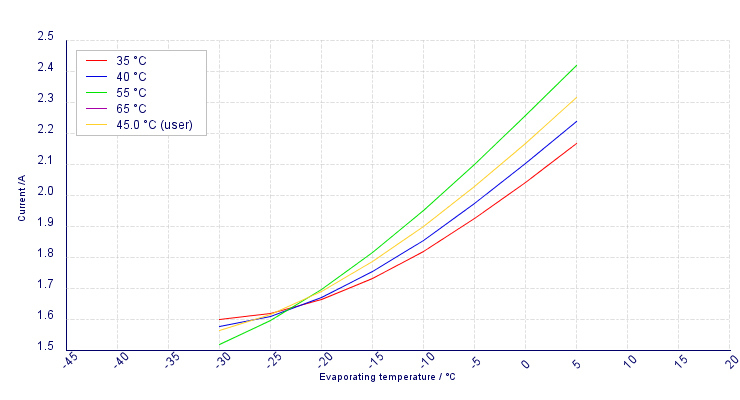Results 1 to 9 of 9
Thread: Typical running amps
-
08-09-2009, 05:30 PM #1
Typical running amps
Let's start a discussion on compressor running amps:
I admit I am not sure how to read if a compressor is running at the correct amps. You can read off the data plate what the locked rotor amps (LRA) are, and the full load amps (FLA)......
For example the LRA may be 30A and the FLA can be 10A; as long as the running amps is below the 10A, I am happy it's not overworking. But if you study refrigeration literature, it mentions that for eg. high subcooling, higher amps, short of refrigerant, lower amps ....
The question then is : Is there a scientific means of ensuring you have the right running amps for various load applications, or am I trying to be over-the-top?
Bonus question: what is the maximum allowable difference in voltage and current draw between phases on a 3-phase compressor?
If at first you DO succeed, try to hide your astonishment!!
-
08-09-2009, 06:03 PM #2
- Join Date
- Sep 2007
- Location
- Split Croatia
- Age
- 57
- Posts
- 6,151
- Blog Entries
- 6
- Rep Power
- 36
-
08-09-2009, 09:28 PM #3
Re: Typical running amps
I thought the rule of thumb was 7 - normal running current + 1/7 of LRA.
Each manufacturer will vary but for an 06E carrier the limmits are 2% for voltage and 10% for current.
-
08-09-2009, 09:53 PM #4
Re: Typical running amps
The 7 to 1 connection between LRA and FLA is a rule of thumb. There can be big differences between single and three phase motors, standard and high efficiency motors and even different motor constructions like internal and external rotor configerations.
I think the the voltage (whilst running with load ) should be within 10% and the current through each of the phases should also be within 10% of each other. The normal running current should also be at least 10% less that the FLA written on the engraving plate of the motor to allow for the effects of small voltage dips. Try not to oversize a motor too much because it can be very innefficient if only running at low load and cost a lot in electricity bills, this is assuming motor is separate from compressor. Efficiency is lot higher at nearer full load. If the compressor has a temperature / Amps load graph from the manufacturer I would guess it should also be accurate to 10% at any given point.
This is all rule of thumb, if the booklet says different then stick to what it says.
I don't think there is a scientific means you can use for knowing if current is correct, I think there are too many variables to consider like power factor which can vary with different loads, supply harmonics present, etc. I think a clamp ammeter, the engraving information and the load graph if one is available is the best you will find without great expense of power analyzers and other intelligent test equipment.Last edited by Frikkie; 08-09-2009 at 10:27 PM.
-
08-09-2009, 10:45 PM #5
-
08-09-2009, 10:47 PM #6
-
08-09-2009, 10:49 PM #7
-
08-09-2009, 11:33 PM #8
- Join Date
- Sep 2007
- Location
- Split Croatia
- Age
- 57
- Posts
- 6,151
- Blog Entries
- 6
- Rep Power
- 36
-
08-09-2009, 11:54 PM #9
- Join Date
- Sep 2007
- Location
- Split Croatia
- Age
- 57
- Posts
- 6,151
- Blog Entries
- 6
- Rep Power
- 36
Re: Typical running amps
Tesla speaking here about ratio of LRA (locked rotor amperage) and FLA (or MRA = maximum runing amperage). That two values you will probably never see in action.
As already pointed that is not formula, that is rule of thumb and you cannot measure it without min/max function on multimeter/clamp meter capable to make sampling faster than 1/10 of second or more.
But with true Rms clamp meter you could very accurately measure running current and compare that with manufacturer data. Compression ratio is variable what determine compressor running current change and tables gives you right current for your conditions.
Similar Threads
-
Problems with compressor running too cold
By abrando1 in forum Trouble ShootingReplies: 8Last Post: 12-05-2009, 10:08 PM -
compressor amps flactuation
By faizsid in forum Trouble ShootingReplies: 3Last Post: 04-09-2007, 02:10 PM -
rewinded and overhaul compressor amps
By faizsid in forum Trouble ShootingReplies: 2Last Post: 01-09-2007, 07:37 PM -
Walkin cooler running to warm need help
By The Butcher in forum Trouble ShootingReplies: 7Last Post: 03-08-2007, 09:19 PM -
Running Costs
By Abe in forum Air ConditioningReplies: 4Last Post: 09-04-2007, 12:58 AM








